by tmoffett | Jul 17, 2010 | Black and White, Landscape, Photographic Philosophy
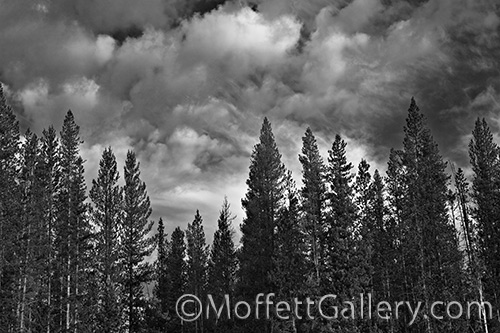
Cloudy Skies
I love the edges. The edge of the light. The edge of situations. The edge of a storm. It seems that everything is more exciting on the edge. Buried in the center is predictability. The light becomes lifeless. The storm is dark and wet. On the edge of a storm you will find clouds that are lively and exciting.
This image was made a couple of years ago and I haven’t been to excited about it. I finally, after passing over it numerous times, decided to print a small print. I do that as I prep images to see the progress and make sure everything is perfect before doing the final, master print. When the 7×10 came out of the printer my heart immediately jumped! the clouds popped and I was hooked. This image definitely has potential. It still needs a bit of work, but it will get there. My process for getting to the master print is a long one. I have in my minds eye a good idea as to what the print will look like when I shoot it. However, I tweak the image and refine it over a period of time until it is just right. Sometimes this takes hours, sometimes days and sometimes weeks. It just depends on the image. But when it is finished, it is just right. It will have a feel to it that sens a message to the viewer and hopefully let them feel what I felt when it was created.
by tmoffett | Jul 15, 2010 | Black and White, Composition, Landscape
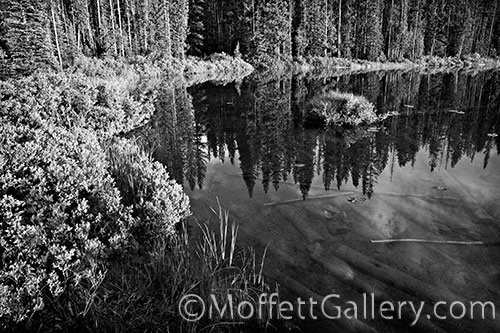
Reflections, Martin Lake
Martin Lake is a favorite destination for a couple of my boys. The morning air is crisp and cool and the lake is generally crystal clear. The fishing is usually quite good as well.
One morning I headed to the lake at sunrise with my camera instead of fishing rod. The early light was just right to highlight the foliage along the shoreline, and the calm water reflected an image of the trees across the way as if it were a mirror. I walked around the lake until I found a location to isolate the mound of grass highlighted by the morning sun against the dark reflection of the trees. I could see the reflection of the clouds on the surface of the water, while at the same time see the fallen trees at the bottom of the lake. It was a wonderful view.
What makes it work? Effective use of leading lines and framing concepts move the eye around the image. The mound of grass gives the eye a resting place before moving through the photograph again.
by tmoffett | Jul 14, 2010 | Black and White, Composition, Critique, Landscape, Photo tips
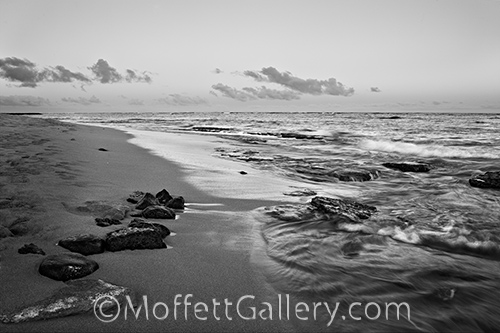
Kapaa Shoreline
Now that we all shoot digital cameras, I think many have forgotten that black and white is even an option. We are shooting color because that is what the camera does. We shoot color for colors sake, and often forget about light quality and tonal range of the image that we are creating. Often, I see images where the color actually gets in the way of the photograph. Toss out the color and the image improves. The photograph above is just such an example, in color, it was very busy. Yellows and reds on the beach, pink and blue in the sky, greens and blues in the water. The placement of the colors just didn’t work, but the tones of the scene were very nice. Learning to see the tones instead of the color is what will make a great black and white photographer.
Shooting for black and white is an art in and of itself that when mastered will dramatically improve your color photography as well. In order for an image to be good in black and white we must look at the tones of the scene. How light is the lightest area and how dark is the darkest area. Morning and evening light, often referred to as the sweet light or the golden hour, give us a reduced contrast and softer light so that detail can be maintained in both highlight and shadow. These are the times of day when I do most of my serious photographing. The light is exciting and most anything will look good.
This image was shot just prior to sunset on the beach in Kauai. The light skimmed across the waves so as to create very nice highlights in the moving water, yet allowed the shadow areas to go dark and rich while still maintaining some detail. Also, as I discussed yesterday, the rule of thirds is used here. I was not consciously thinking about it, but having developed an eye for composition, it just happens. Notice when a grid is placed over the photograph, where the intersecting points fall. 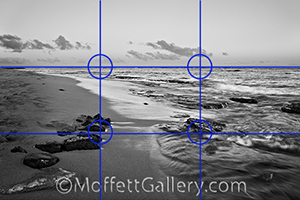 On the rocks to the left, the reef on the right and also the horizon line is on the top horizontal grid line.
On the rocks to the left, the reef on the right and also the horizon line is on the top horizontal grid line.
Practice shooting black and white and apply the principles of composition and watch your photographs improve!
by tmoffett | Jul 13, 2010 | Black and White, Composition, Landscape, Photographic Philosophy
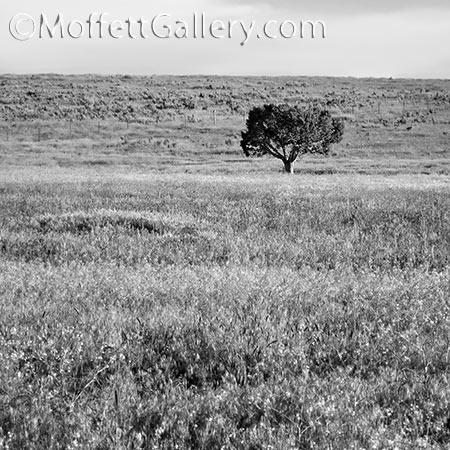
Isolation, Cassia County, Idaho
Composition in landscape photography is sometimes a touchy subject, but in my opinion is very critical to discuss. Some see good composition naturally… it is a gift they have, others must learn to see. Neither way is necessarily better than the other, just different ways of seeing. I often hear that “rules were meant to be broken.” Yes, but I also once heard that “knowing the rules and intentionally breaking them is the difference between art and accident.” We must understand and recognize good compositional design.
The first basic rule of composition that I each is the Rule of Thirds. It is a simplified derivation of the Golden Mean. This basic rule will do more to improve your photography than any other rule of composition. In a nutshell, what it states is that if you divide your frame into thirds both horizontally and vertically, the strongest points to place the main subject matter is on one of the intersecting points. Basically, avoid centering the subject. At first this may seem odd, and sometimes difficult as you must also maintain visual balance, but as you practice and develop an eye for better composition, it will become very natural.
In this image, if we were to overlay a grid dividing the photograph into thirds, you would find that the intersection of the top and right third lines is right over the tree. There are some other compositional elements at play in this image that help it as well, but the main one is the Rule of Thirds.
Oftentimes we get in such a hurry to get the shot that we forget to really scrutinize what is in the viewfinder. Slowing down and checking every square millimeter of the viewfinder will help us to eliminate everything that distracts from the subject, thus allowing a more simple and powerful image. It is my philosophy that slowing down will allow me to get one really great photo, which is much better than coming home with ten mediocre images.
Slow down, check and recheck the viewfinder and apply the rule of thirds and you will notice drastic improvements in your images.
by tmoffett | Jul 1, 2010 | Black and White, Landscape
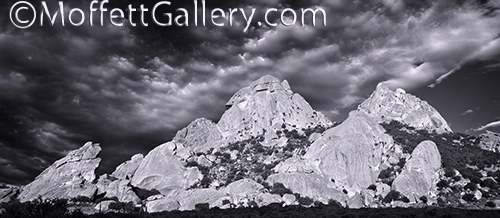
Twin Sisters, City of Rocks National Monument
It was a beautiful morning in City of Rocks National Monument last Saturday. We left Burley at about 4:30 AM in order to get there by sunrise. We stopped once to photograph the lunar eclipse. Had some interesting clouds that were illuminated by the moonlight. It is wonderful to get away from the city and enjoy nature for a while. It is even better to be able to photograph it!
We had been photographing around Twin Sisters prior to sunrise and made some good color images. However, we were just about to move on and check out other areas when the sunlight completely engulfed the rock and these wonderful clouds positioned themselves perfectly behind the rock. We stopped and photographed some more. The light was great for black and white, so that’s what I did.
I felt like I just figured out how to shoot here and the light quality weakened. This is a place I could definitely come back to. It always seems to take a couple of times in one area to really get a feel for what I want to do. The photographs get better with each visit. That is why I am a big advocate of photographing in your local area. You are familiar with it, therefore able to do a much better job with it.
by tmoffett | Jun 19, 2010 | Black and White, Landscape, Photo tips, Uncategorized
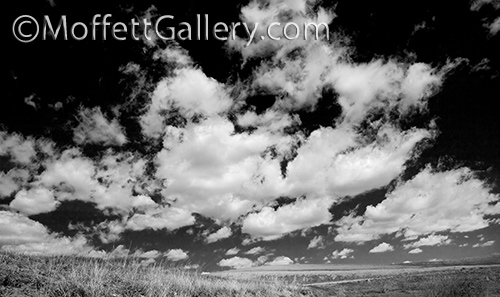
Winder Reservoir
I love going to new places. I was out with some friends a while back over in South-Eastern Idaho and we decided to find somewhere to go fishing. We ended up at Winder Reservoir mid morning and wet our lines. The sun came out and it got hot and the fish were not biting. I decided to get out the cameras and make photographs. The light was pretty harsh, so I focused on the clouds that were drifting by. I have found that during the day when lighting is less than ideal, the clouds often look wonderful. That was the case that morning.
I also love black and white. In my formative years in photography that is all I shot. Very rarely did I even consider color as an option. This was an ideal time to load the camera with black and white film, put on Wratten 25 filter and shoot away. The trouble was I had no film camera with me. So I shot away with my Canon 5D, visualizing what the image would be in black and white, then when returning home converting the original color to the pre-visualized rendering of the image. By minimizing the foreground and emphasizing the sky and clouds, I was able to create a visually pleasing image in the harsh light of the late morning sun.
Photogaphs can be created any where and anytime. We just need to know where to look. Recognizing what we can do in different lighting conditions is a skill that takes much practice. I am still learning. Shooting and evaluating are both necessary to learn this skill. Many times we forget the evaluation step, but without it we will keep doing the same things over and over and never learn. Take the time to review what you do. Show others and get feedback. That is what really helps.
Happy shooting!








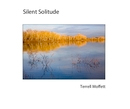
Recent Comments